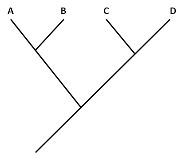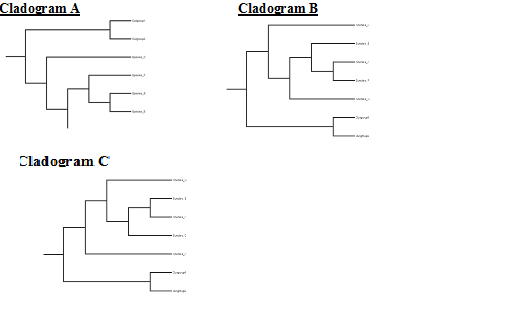Reference no: EM13933176
Systematics: The methods and application of phylogenetic and taxonomic analysis
Adapted from "Labs for Vertebrate Zoology: an Evolutionary Approach" Gergus and Schuett, 2000, Cooper Publishing
Systematics Lab, Dr. Dan Duran; Vanderbilt University
The Complete Cladist; Wiley, et al 1991; University of Kansas, Special Publication
Objectives:
- To become familiar with the principles of systematics.
- To understand the terms, methods and concepts employed in phylogenetic systematics
- To understand the principles of phylogenetic classification
- To use this knowledge to reconstruct the evolutionary relationships of a hypothetical group of organisms
Background and Introduction:
Systematics, as a science, is concerned with both Phylogenetic Reconstruction and Taxonomy. Reconstruction allows us to hypothesis on the evolutionary relationship between two or more organism after comparing characteristic. Taxonomy affords us the ability to communicate these relationships by grouping and naming species which are similar. The two processes must work together. Indeed, the key principle of modern taxonomy is that named groups of organisms, or taxa, should be defined according to their evolutionary relationships.
Once these relationships are developed they are used to construct a cladogram (fig. 1) which visually represents ancestor-descendant relationships.

The basis for determining evolutionary relationships is the concept of Homology; organisms descending from a common ancestor will share features or homologous characters. The characters under evaluation must be inheritable traits. Initial characters were structural ( i.e. beak length) but now include behavioral, embryological, physiological and , with the increasing ease of DNA isolation and sequencing, chromosomal and genetic homologies.
When considering which character traits to evaluate it is important to understand they are not all created equal. Some carry more phylogenetic information than others.
1) Symplesiomorphies are shared ancestral characters. They aren't phylogenetically informative because these traits are possessed by all of the taxa that we are examining (and therefore this character was presumably in the common ancestor of all). For example, if we are trying to resolve the relationships between species of owls, we would find that the presence of feathers was a symplesiomorphy. All members of the group have feathers and so it doesn't help us understand the relationships within the group.
2) Autapomorphies are unique derived characters. This type of character is distinctive for a taxon (i.e. an elephant's long trunk) and it enables us to identify that taxon, but autapomorphies also tell us nothing about a taxon's relationship to other groups. Thus, this kind of difference is also not phylogenetically informative.
3) Synapomorphies are shared derived characters. These are the only characters that really help us to resolve relationships (i.e. are phylogenetically informative). For example, if we are trying to create a phylogeny of several bird species and we observe two of the species have three toes while all other species have four, then it is most parsimonious (simplest) to infer that the two three-toed species are most closely related because both species likely inherited this trait from a common ancestor which also had three toes.
However, sometimes a trait will exist in two taxa, but will not be due to common ancestry. Such a situation could arise when two groups independently evolve that character. For example, if we were trying to construct a phylogeny of vertebrate animals, we would see that both birds and bats have wings, and perhaps we would think this meant both groups were more closely related to each other than they are to any other animals which lack wings. In this case we'd be incorrect because it turns out that both birds and bats evolved wings independently through convergent evolution and we would refer to this convergent character as a homoplasy.
Another example of homoplasy is character reversal which occurs when a character state reverts to a condition similar to an ancestral state. For example the loss or reduction of eyes in cave dwelling fish.
Informative character states can also be evaluated via additional criteria. Is the trait discrete (qualitative) or continuous (quantitative)? Is the state binary (i.e. present or absent; straight or curved) or multistate ( i.e. brown, red or yellow feathers)
Phylogenetic analysis is further strengthened by the use of outgroup analysis. This is an assessment of the characters in the closest relatives (the outgroup) to the taxon being studied (the ingroup). And trait(s) being shared by both groups is termed ancestral; conversely, any character state present only in the ingroup is considered derived or apomrophic.
Once all the character traits have been identified and evaluated between the studied organisms the evolutionary relationships can be hypothesized using a method such as maximum parsimony. Maximum parsimony makes use of characters (traits) to find the phylogenetic tree that most easily explains the data. We choose the tree that involves the smallest number of character changes, that is, the most evolutionarily parsimonious tree. We are basing this on the assumption that most shared derived characters are due to common ancestry, not convergence. For this exercise we will use a relatively small number of taxa and a small number of characters, but typical datasets often involve a much larger number of taxa and can include hundreds or even thousands of characters. Furthermore, the number of possible cladograms increases exponentially as we increase the number of taxa we're looking at. If we were looking at 10 taxa, there are over 2 million(!) possible relationships that could exist, so phylogenies are always created with computers to make the task manageable.
In addition to maximum parsimony, there are several other methods which are used to generate
phylogenetic trees, and one of these is called Neighbor-Joining. N-J is a bit more complicated but essentially works by looking at the percentage of differences in traits between taxa. N-J creates a tree based upon which taxa are most similar overall. Without going into too much theory, it turns out that N-J and parsimony often give us the same result when there is sufficient data.
Phylogenetic Analysis: The General Procedures
To complete the following exercise we must first identify presumed homologous characters among the organisms under study. Then we must assess the direction of character change or modification. Finally, we construct a cladogram of the taxa.
1) Select an ingroup to study. The ingroup must be monophyletic (i.e. share a common ancestor)
2) Designate terminal taxa within your ingroup. These may be individual species or larger monophyletic groups.
3) Define an outgroup or outgroups to determine character state polarity (defining ancestral v derived character states)
4) Look for and delimit characters and character states within the ingroup. Characters must have two or more character states within the ingroup to provide information on relationships.
5) For each character, determine which state is ancestral (plesiomorphic) or derived (apomorphic) by comparing the ingroup to the outgroups. It is assumed a character state present in both groups is ancestral.
6) Working with each character at a time group the taxa that share derived states (synapomorphies). Construct a cladogram to depict these relationships.
7) Repeat step 6 until all character states are represented on the cladogram.
In class exercise:
You will be working in groups of 4-6.
Look at the pictures of the hypothetical fish species below. Work with your group to identify a list of characters and their character states.
Construct a character matrix and evaluate each ingroup species.
Homework to be completed and uploaded to the Assignments section of the web page.
Each group will use this data to construct a cladogram with the synapomorphies included and a phylogenetic taxonomy which reflect the relationships in the final cladogram.
Questions to answer:
1. Please insert a table representative of the character matrix constructed by your group for the hypothetical taxa of fish.
2. Are any of the characters uninformative regarding phylogenetic relationships among the species? If so then tell us which of them and why?
3. Which species share the largest number of derived character states?
4. Compare the following three cladograms we have generated from our character matrix. Which of them is the most parsimonious (i.e. required the least number of changes to the character states to achieve)?

5. For the tree your group has deemed most parsimonious label or list the specific evolutionary changes/steps required at each branch point?